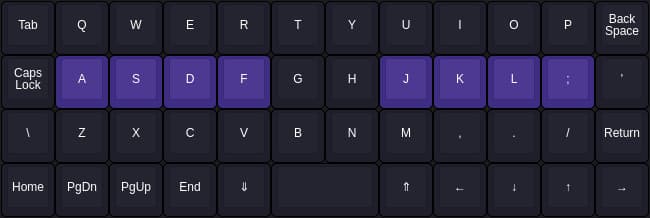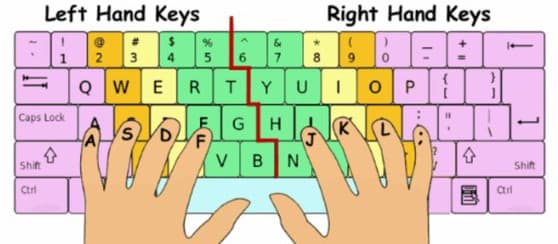When you can type accurately without looking at the keyboard, and you use the correct finger for each key, your typing speed (WPM) will increase dramatically. If you want to increase your productivity and save time, touch typing is one of the most effective ways to do this. With some patience and practice, anyone can learn to type correctly.
Touch Typing Basics
After you have learned the correct typing posture, the next step is to learn the basics of typing correctly. The fundamentals of touch typing are placing your fingers on the "home row" keys, using the correct finger to type each key, and returning your fingers back to the home row. With practice, you will be able to type without looking at the keyboard. You won't have to even think about where each key is, your fingers will know the way.
Home Row

The "home row" is the foundation of touch typing. Putting your fingers in the same place every time allows you to learn where the keys are without having to look at the keyboard. The correct way to position your fingers is to place your left hand on the A, S, D, and F keys; and your right hand on the J, K, L and semicolon. One or both of your thumbs should rest on the spacebar. Most keyboards will have two little bumps on the keyboard to help you line your fingers up without looking.
Use the Correct Fingers For Each Key
Each key on your keyboard is assigned to a specific finger, and you should use the correct finger every time. The picture below shows which keys are assigned to each finger. You shouldn't have to memorize this, just keep it in mind as you are practicing your typing. When you need to use the "shift" key, (to capitalize a letter or use a secondary character,) you should be using one hand for the letter and the other hand for the shift key.

Return Your Fingers to the Home Row
It almost goes without saying. After each letter you type, make sure that your finger finds it"s way back to the home row as quickly as possible. Of course, there are times when the same finger types two letters in a row. You should practice the common combinations without bringing your finger home, but the key to learning to touch type is training your fingers to instinctively move from the home row to the correct key.
The average typing job will require you to type over 40 WPM, while more advanced jobs may require 80 WPM. Even if you do not plan on typing full time for your job, typing faster and more accurately is a very valuable skill that is worth taking time to learn.
Special Keys
There are many other keys on your keyboard which can come in handy. Some of these keys are made almost obsolete with the invention of the mouse, but in many ways it is quicker and easier to use the keyboard. I am only familiar with American keyboards, so I apologize if this does not apply.
Shift
The "shift" key is for capitalizing letters, or using the secondary character of a key. (Example - On the number 1 key, you should see an exclamation mark.) It is also used with the arrow keys to highlight text.Caps Lock
This key is used if you want to type in all capital letters. Use "shift" to make a letter lowercase. Using the caps lock is not the same as holding the shift key down, it only affects letters.
Tab
The "tab" key indents your paragraph. Many word processing programs allow you to adjust the indent. Tab is also very useful when you are filling out forms on the internet. Press it to move your cursor to the next item on the form instead of using your mouse.
Backspace
The "backspace" key is used to delete the character to the left of the cursor. It is also used to delete highlighted text.
Delete
The "delete" key is used to delete the character to the right of the cursor. It is also used to delete highlighted text.
Home
The "home" key is used to move the cursor to the beginning of the line.
End
The "end" key is used to move the cursor to the end of the line.
Ctrl (Control)
The "ctrl" key is used to perform special functions. It is also used with the arrow keys to highlight text.
Alt
The "alt" key is used to perform special functions. It is also used with the arrow keys to highlight text.
Enter
The "enter" key is used to start a new line. It is also used to submit forms on the internet.
Page Up
The "page up" key is used to move the cursor to the beginning of the document.
Page Down
The "page down" key is used to move the cursor to the end of the document.
Esc
The "esc" key is used to cancel a command. It is also used to exit programs.
Print Screen
This will not actually print anything. This key is for taking a screenshot - a picture of your entire screen.
Ready for some practice? Take a typing test now!